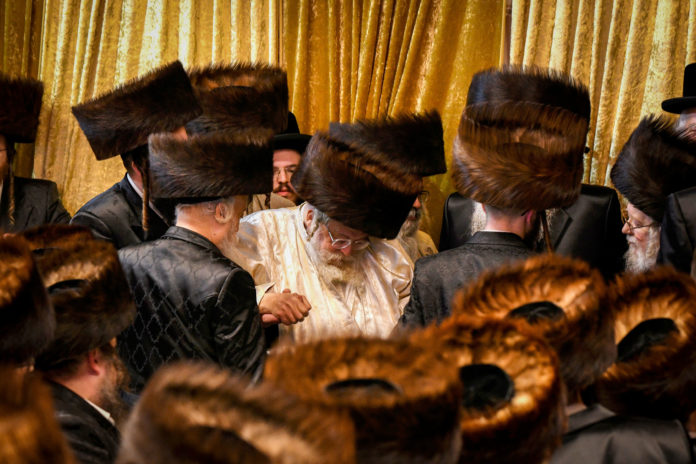
There is perhaps no Rebbe-chasid relationship more intriguing than the one that bound the Toldos Avrohom Yitzchok Rebbe, Rav Shmuel Yaakov Kohn, with the Imrei Chaim of Vizhnitz. The avodah of the Vizhnitzer Rebbe—indeed, his entire geist, as well as his approach to the State of Israel—differed considerably from that of Rav Shmuel Yaakov’s father, the Toldos Aharon Rebbe, Rav Avrohom Yitzchok Kohn, zt”l. Headquartered in Meah Shearim, the Toldos Aharon community was known for its very strict and devout ways and fervently anti-Zionist and anti-Agudah philosophy. That the Toldos Avrohom Yitzchok Rebbe was able to maintain a delicate balance between the path of his father and the Imrei Chaim, who was one of the leaders of Agudas Yisrael and encouraged his followers to take part in the Israeli elections, is enthralling.
The Toldos Avrohom Yitzchok chasidus traces its roots to the Rebbe’s grandfather, Rav Aharon Roth, who in 1921 established a small group of devout followers in the Romanian city of Satmar, known as Reb Ahrelach, who agreed to adhere to a pious lifestyle controlled largely by Rav Aharon’s takanos. After encountering some opposition from other chasidic rebbes because of his stringencies, Rav Aharon immigrated to Eretz Yisrael in 1928. Settling in Yerushalayim, he started to attract many new members, and his small movement eventually evolved into a full-fledged chasidus. After his passing on 6 Nisan 5707 (1947), the chasidus split, with a relatively small group choosing his son, Rav Avraham Chaim Roth, to succeed his father as Rebbe. His son retained the name Shomrei Emunim, which was the original name given to the community by Rav Aharon. Most of his chasidim, however, chose Rav Aharon’s son-in-law, Rav Avrohom Yitzchok Kohn, who named his new kehillah Toldos Aharon.
After Rav Avrohom Yitzchok’s passing the chasidus split again, and his son Rav Dovid inherited his father’s position as the Toldos Aharon Rebbe, while his eldest, Rav Shmuel Yaakov, founded a new chasidus under the name of Toldos Avrohom Yitzchok. Today, Rav Shmuel Yaakov and his younger brother Rav Dovid, both based in Meah Shearim, lead sizable chasidic communities, with followers throughout the Jewish world. I recently paid a visit to the Toldos Avrohom Yitzchok Rebbe in his home on a narrow street right off Rechov Meah Shearim.
Early Stirrings
Accompanying me today is the Rebbe’s son Rav Chaim Meir, who leads a branch of his father’s community in the Israeli city of Beitar. In fact, Rav Chaim Meir is named after the Imrei Chaim. As 9 Nisan marks the 50th yahrtzeit of the Imrei Chaim, I tell the Rebbe after he greets me warmly and we exchange some niceties that I would be fascinated to hear his recollections of the Vizhnitzer Rebbe.
At first, the Rebbe shows reluctance. “A person is not a tape recorder. On a tape recorder, you can press the button and it starts to speak. A person cannot do that. Sometimes one remembers certain things, and other times he doesn’t remember them.” But after some prodding by his son, the Rebbe acquiesces.
“I would frequently join my father in his visits to the Rebbe,” he allows.
Indeed, as he recalls it, the Rebbe’s hiskashrus to the Imrei Chaim began at a very early age.
“In 5708 (1948), the Imrei Chaim came to Yerushalayim. My father went to visit him and took me along. I was around five years old at the time, but I still remember how the Imrei Chaim looked. Years later, my mother told me that when I returned from that first visit, I declared that I loved this Rebbe very much—he was a ‘batamter rebbe’—although I don’t remember saying that. Then shortly after my bar mitzvah, in the summer of 5717 (1957), my father sent me to learn in the Vizhnitzer yeshivah in Bnei Brak.”
I ask the Rebbe if there weren’t enough yeshivos in Yerushalayim for him to attend.
“There were Litvishe yeshivos,” he answers, “but there weren’t any proper chasidishe ones. My father was very close to the Yeshuos Moshe [the Imrei Chaim’s son and successor], and when my father told him that he didn’t think he had a yeshivah for his son, the Yeshuos Moshe said, ‘Send him to our yeshivah, where he’ll be able to grow.’
“The Imrei Chaim,” the Rebbe continues, “invested a lot of effort in raising the standard of the bnei hayeshivah, which led to the good name of the yeshivah spreading far and wide. That is why my father ultimately decided to send me to Vizhnitz.”
“But the Rebbe’s father considered himself a talmid of the Satmar Rebbe,” I say, trying to understand the Toldos Aharon Rebbe’s decision.
“That’s correct. My father learned by the Satmar Rebbe in Krula, and would later visit him whenever he went to America to collect money for the yeshivah. But he would also go to the Imrei Chaim.”
“Did the Rebbe’s father visit him frequently?” I inquire.
“Yes,” he says, and then shares an interesting story.




















